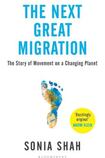
Sonia Shah and her publishers cannot have anticipated that this book would emerge at such an apposite time. Written in the context of a decade of growing political tension surrounding migration in both Europe and the US, it has been released at the precise moment when so many of us are questioning the morality of racial categorisation and how it is used to oppress.
The Next Great Migration is a bracing book. At its core is a dismissal of spurious categorisation, and the use of categories to keep things in their place, whether geographically, politically or in any other sense. She deconstructs the idea that particular flora and fauna belong only in specific settings and that their movement is somehow aberrant or unnatural. In fact, living things – understood in the broadest sense – have been moving forever.
The book is rich with examples, including the beech trees Shah encounters in late autumn in the mountainous forests of Vermont, near the Canadian border. Though forgotten to all but the most dedicated botanists, this particular species is not truly native to that part of North America but is from much further south. It holds on to its leaves for longer and attracts migratory bears from hundreds of miles away to eat its nuts.
My childhood garden in Co Down had two enormous beech trees, and few environments ever seem as natural and automatic as the garden a child learns to climb trees in. Except I only just learned – prompted by this book to investigate – that beech are not in fact native to Ireland, and were first planted here in the 18th century.
Our tendency – or our need – to categorise living things as native or foreign is, of course, a large part of the political context in which immigration is debated. This book convincingly places these modern-day political debates in an intellectual history that is essential to understanding how they came about.
From the earliest European explorations of America and Africa there emerged a desire to not only catalogue the visual differences between pale-skinned colonists and indigenous people, but to ascribe hierarchies of physical or intellectual attributes. This is putting it mildly.
As Shah argues, a significant part of the study of biology over several centuries was devoted to proving made-up principles of racial categorisation, and specifically racial hierarchy. Prime among the intellectual architects of scientific racism was Carl Linnaeus, the 18th-century Swedish naturalist sometimes known as the father of modern taxonomy.
Scientific racism
Linnaeus advanced a clearly racist approach to his scientific method, fixating on minor aesthetic differences between humans living in different climates on different parts of the globe. He created an entire taxonomy of what he believed were separate human sub-species, complete with Latin names – such as Homo sapiens americanus, ie Native Americans – and glib descriptions; “red, ill-tempered, subjugated… ruled by custom”. Of Homo sapiens asiaticus, “yellow, melancholy, greedy”. His most offensive, toxic depictions were of people from the continent of Africa.
Linnaeus never left Sweden, and seems to have encountered only a small number of people of colour in his life. But his taxonomy will have indirectly harmed many millions of non-white people, and may still be doing so today.
If structural racism describes systems that are constructed in a way that discriminates against non-white people – even when well-intentioned individuals are unconscious of it – Shah convincingly argues that these early structures of categorising and ranking humans persist in preventing us from seeing people of all colours as, basically, the same.
Shah, a science writer, manages to link questions of migration, race and ecology more fluently than most political or social affairs journalists. Of course, race, nationality and borders are not based on nature, or science – they are social and political constructs. And as an enormous ecological upheaval approaches, part of the point of this book is to warn us that narrow political categorisations may end up being as damaging as the pernicious racial categorisations with which non-white people still struggle.
Every location on Earth is touched by migration, but some places endure a particularly uneasy relationship with the movement of people. Few more so than Ireland. First through the widely-held sense that too many people have had to leave this island over centuries and, second, from the continued desire among some to categorise ourselves internally, based on a 400-year-old migration from the island immediately to our east.
The scale of human emigration from here and the complexities of our Border both loom in our minds and in our history. If we viewed it from a more scientific perspective, or from the perspective of a migrating bird landing briefly on Inisbofin to enjoy the view on its way across the Earth, we might give ourselves a break.
Matthew O’Toole is an SDLP MLA for Belfast South.









